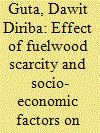| Srl | Item |
| 1 |
ID:
116737


|
|
|
|
|
| Publication |
2012.
|
| Summary/Abstract |
It is well known that poor rural households in low-income economies are reliant on traditional fuels to meet basic domestic energy needs, but little is known about the specific underlying socio-economic drivers of residential fuel choices in Ethiopia. I used the linear approximation almost ideal demand system (LAAIDS) with normalized prices to compute expenditure elasticity and a multinomial logit model (MLM) to examine household fuel use. The LAAIDS model result showed that expenditure was elastic for modern fuels, but inelastic for traditional fuels. Regression results from the MLM indicated that fuel choice behaviour of rural households could be more accurately described as 'fuel stacking' behaviour as opposed to the 'energy ladder' hypothesis. In rural areas household fuel choice may be constrained by limited access to commercial fuels and efficient cook stoves, supply dependency and affordability, consumer preferences and a web of other intricate factors. Rural households had less incentive for fuel switching due to underlying factors and the availability of fuel wood without direct financial cost. With continued deforestation and receding forests, households are expected to develop inter fuel substitution and switching behaviour conditional on access to modern energy technologies.
|
|
|
|
|
|
|
|
|
|
|
|
|
|
|
|
| 2 |
ID:
136232


|
|
|
|
|
| Summary/Abstract |
In Ethiopia biomass is predominantly utilized for household energy needs often using inefficient rudimentary stoves which cause adverse environmental and welfare effects. This paper examined the contribution of biomass resources to rural household energy use and energy substitution. The analysis applied the ordinary least square in the final stage estimation of fuelwood and overall biomass energy consumption by using predicted shadow prices. The paper used Tobit model to estimate charcoal and agricultural fuel consumption due to the presence of censoring. An increase in fuelwood shadow price was associated with reduced household fuelwood consumption with price elasticity of −0.38. The cross price elasticity between fuelwood and agricultural fuels revealed no evidence of energy substitution, which conforms to the findings of previous studies. Household access to electricity was associated with lower household biomass energy utilization but kerosene was not fuelwood substitute. Household energy use conformed to the ‘fuel stacking’ or ‘multiple fuel use’ concept, but households preferred modern energy options as welfare increased in areas where modern energy is available. This suggests that there is a promising prospect for fuel-transition, but access to modern energy and economic growth have key roles. The findings suggest that a concerted policy effort is required that would help diversify rural livelihoods, improve living standards and encourage economic growth, encourage inter-fuel substitution through improved modern energy access and afforestation to increase biomass supply.
|
|
|
|
|
|
|
|
|
|
|
|
|
|
|
|